Interpublic Group Bundle
What's the Story Behind the Interpublic Group?
Ever wondered how a single entity came to dominate the complex world of advertising? The Interpublic Group (IPG), a marketing company giant, emerged from a groundbreaking idea in the mid-20th century. This Interpublic Group SWOT Analysis can provide deeper insights. Its formation marked a pivotal moment in the advertising agency landscape, shaping the industry as we know it.
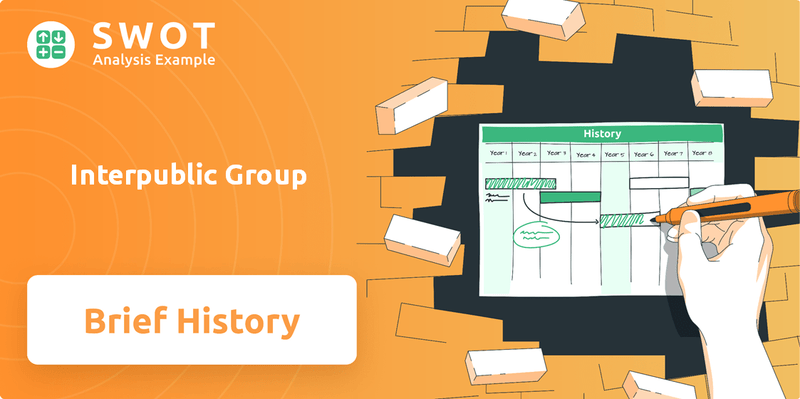
From its humble beginnings in New York City, the IPG history is a tale of strategic acquisitions and innovative approaches. Understanding the brief history of Interpublic Group of Companies reveals how it adapted to the ever-changing demands of the marketing world. Today, IPG stands as a leading media holding company, a testament to its enduring vision and commitment to excellence.
What is the Interpublic Group Founding Story?
The Interpublic Group (IPG) has a rich history that began with a forward-thinking vision in the advertising world. Officially established on July 1, 1961, IPG emerged from McCann-Erickson, Inc., a well-known advertising agency. This strategic move aimed to reshape how marketing and communications services were delivered.
Marion Harper Jr., the former CEO of McCann-Erickson, was the driving force behind the creation of IPG. He saw the need for a new organizational structure that could manage the increasing specialization within the marketing and communications industry while maintaining client confidentiality. This innovative approach set the stage for IPG's future as a leading media holding company.
The primary goal was to create a holding company that would own various marketing and advertising agencies, each operating independently. This structure allowed IPG to offer a broad spectrum of services without forcing agencies to merge their operations or client rosters. The initial funding for IPG came from the financial strength and assets of McCann-Erickson.
IPG was founded on July 1, 1961, by Marion Harper Jr. as a holding company. Harper recognized the need for a new organizational structure in the advertising industry. The initial funding came from McCann-Erickson, a well-established advertising agency.
- IPG's business model was revolutionary for its time, allowing agencies to operate independently.
- The company aimed to integrate various disciplines like advertising and public relations.
- The cultural and economic context of the early 1960s provided fertile ground for Harper's venture.
- IPG's early success was built on a diversified portfolio of specialized agencies.
The original business model of Interpublic Group was revolutionary for its time: it was conceived as a holding company that would own various marketing and advertising agencies, each operating independently with its own clients and specializations. This structure allowed IPG to offer a broad spectrum of services without forcing agencies to merge their operations or client rosters. The first 'product' offered by IPG was essentially this diversified portfolio of specialized agencies. While specific anecdotes about the company name selection are not widely publicized, 'Interpublic' likely reflected the interconnected and public-facing nature of its various marketing and communications services. Initial funding for IPG came from the existing financial strength and assets of McCann-Erickson, which was already a well-established and profitable entity. Harper's vision was to create a 'total marketing communications' company, a concept that was ahead of its time and aimed to integrate various disciplines like advertising, public relations, and market research under a single corporate umbrella. The cultural and economic context of the early 1960s, marked by increasing consumerism and the rise of mass media, provided fertile ground for Harper's ambitious venture.
The Revenue Streams & Business Model of Interpublic Group has evolved significantly since its founding. The company's early acquisitions and strategic partnerships played a crucial role in its growth. IPG's global presence expanded as it acquired and integrated various agencies worldwide, establishing itself as a major player in the advertising and marketing industry. The company's financial performance, driven by its diversified portfolio, has consistently reflected its market position.
In recent years, IPG has continued to adapt to the changing media landscape. The company's subsidiaries and agencies have played a key role in its success. IPG's current market position is a testament to its ability to innovate and meet the evolving needs of its clients. As of 2024, IPG's future outlook remains positive, with strategic investments in digital and data-driven marketing solutions.
Interpublic Group SWOT Analysis
- Complete SWOT Breakdown
- Fully Customizable
- Editable in Excel & Word
- Professional Formatting
- Investor-Ready Format
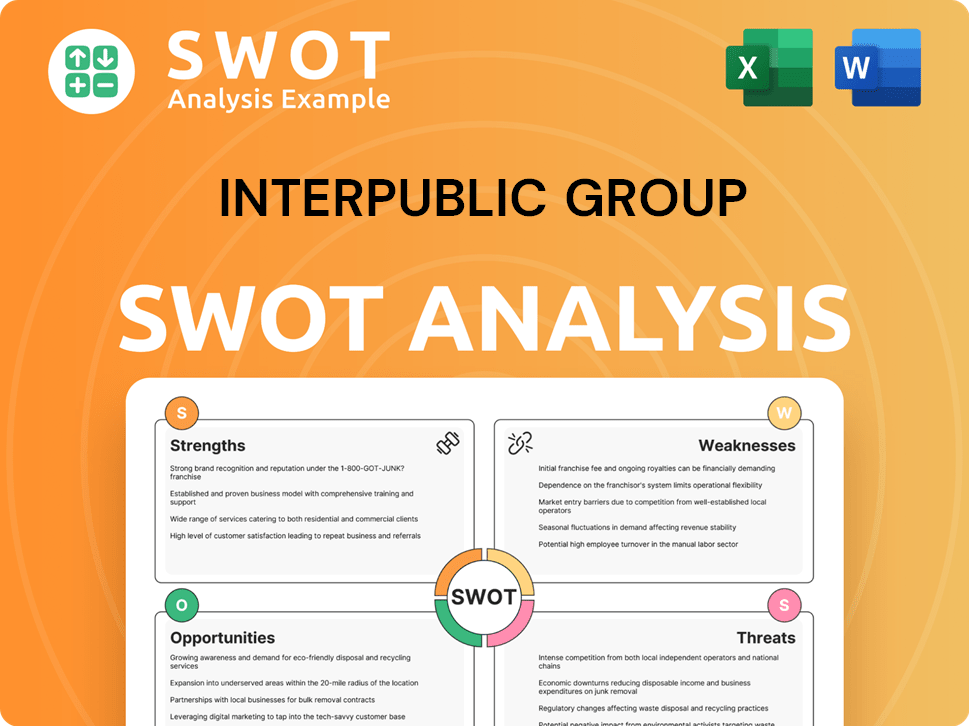
What Drove the Early Growth of Interpublic Group?
The IPG history began in 1961, marking the start of an aggressive growth phase for the Interpublic Group. This expansion was primarily fueled by strategic acquisitions, designed to build a comprehensive suite of marketing services. The IPG company quickly integrated various agencies to meet the evolving needs of its clients.
Early on, the Interpublic Group focused on acquiring agencies to broaden its service offerings. This included agencies specializing in public relations, such as Communications Affiliates Inc., acquired in 1960, and market research firms. These acquisitions allowed IPG to offer a wider range of services beyond traditional advertising, which was crucial for its early growth.
Interpublic Group's expansion strategy included entering new markets both geographically and in specialized marketing disciplines. The company rapidly established a global footprint, expanding into Europe, Latin America, and Asia. This internationalization was a key part of its growth, reflecting the increasing globalization of its clients' businesses. The advertising agency model was evolving.
Throughout the 1960s and 1970s, Interpublic Group continued its acquisition spree, integrating agencies like Erwin Wasey, Ruthrauff & Ryan, and Campbell-Ewald. These mergers and acquisitions significantly shaped IPG's trajectory, allowing it to gain market share and diversify its expertise. Leadership transitions, with figures like Marion Harper Jr., played a crucial role in guiding the company during this period.
The market generally received Interpublic Group's holding company model positively, providing clients with a single point of contact for various marketing services while allowing agencies to maintain their identities. The competitive landscape was intensifying with the rise of other advertising conglomerates. IPG's proactive acquisition strategy positioned it as a major player in the global marketing company arena. Learn more about the Owners & Shareholders of Interpublic Group.
Interpublic Group PESTLE Analysis
- Covers All 6 PESTLE Categories
- No Research Needed – Save Hours of Work
- Built by Experts, Trusted by Consultants
- Instant Download, Ready to Use
- 100% Editable, Fully Customizable
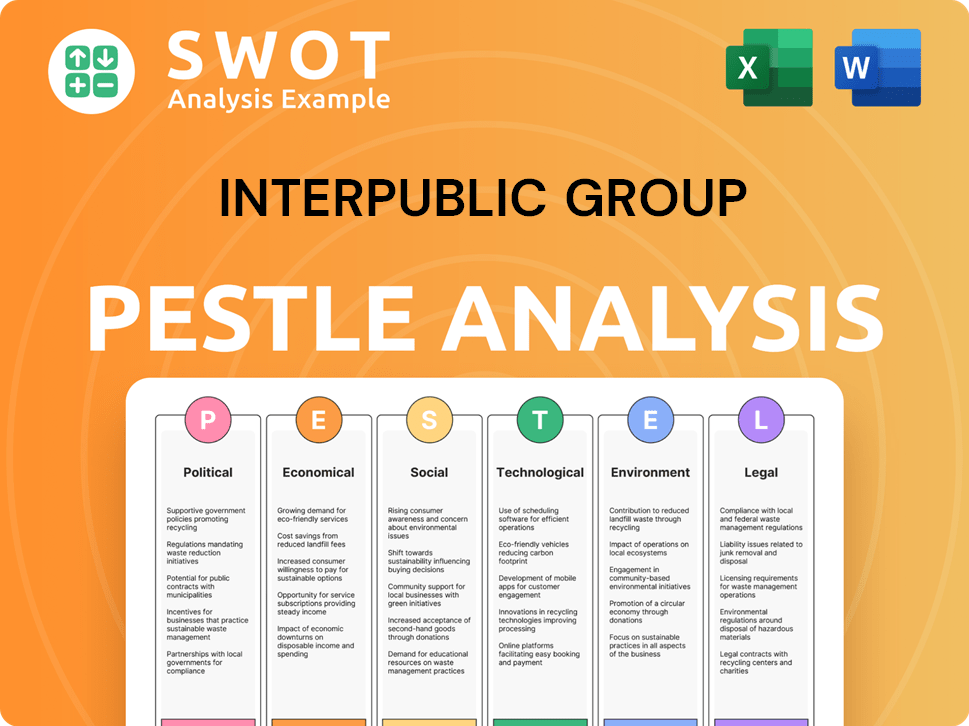
What are the key Milestones in Interpublic Group history?
The Interpublic Group (IPG) has a rich IPG history, marked by significant milestones that have shaped its trajectory as a leading media holding company. From its inception, the IPG company has evolved, adapting to the ever-changing landscape of the advertising and marketing industry.
| Year | Milestone |
|---|---|
| 1961 | Founded as a holding company, pioneering the concept of integrating various marketing disciplines under one roof. |
| 2001 | Acquired Foote, Cone & Belding (FCB), significantly expanding its global reach and client portfolio. |
| 2018 | Acquired Acxiom for $2.3 billion, enhancing its data management and analytics capabilities. |
| Ongoing | Continuous expansion of its global footprint, with operations in over 100 countries. |
Interpublic Group has consistently demonstrated innovation in its business model and service offerings. A key innovation was its foundational concept of a diversified holding company, which allowed for the integration of various marketing disciplines while maintaining agency autonomy.
Pioneered the concept of a diversified holding company, integrating various marketing disciplines under one roof.
Strategic acquisitions of agencies like FCB and Acxiom expanded capabilities and market presence.
Increased investment in digital capabilities and data analytics to meet evolving industry trends.
Emphasis on data-driven marketing through initiatives like the acquisition of Acxiom, enhancing data management and analytics.
Despite its successes, IPG has faced several challenges throughout its history. The late 1990s and early 2000s saw market downturns and internal financial issues, which led to restructuring and strategic pivots.
Navigated market downturns, including the dot-com bubble burst and the economic impact of 9/11, affecting advertising spending.
Addressed internal financial irregularities in the early 2000s, leading to restatements of earnings and management instability.
Faced competitive threats from emerging digital agencies and the rise of in-house marketing teams.
Undertook significant restructuring efforts, divesting non-core assets, and focusing on strengthening core advertising and marketing services.
Increased emphasis on data-driven marketing through initiatives like Acxiom, acquired in 2018 for $2.3 billion.
Continuous investment in future-oriented capabilities to adapt to market shifts and maintain a competitive edge.
For further insights into Interpublic Group's core values and mission, consider reading Interpublic Group's Mission, Vision & Core Values.
Interpublic Group Business Model Canvas
- Complete 9-Block Business Model Canvas
- Effortlessly Communicate Your Business Strategy
- Investor-Ready BMC Format
- 100% Editable and Customizable
- Clear and Structured Layout
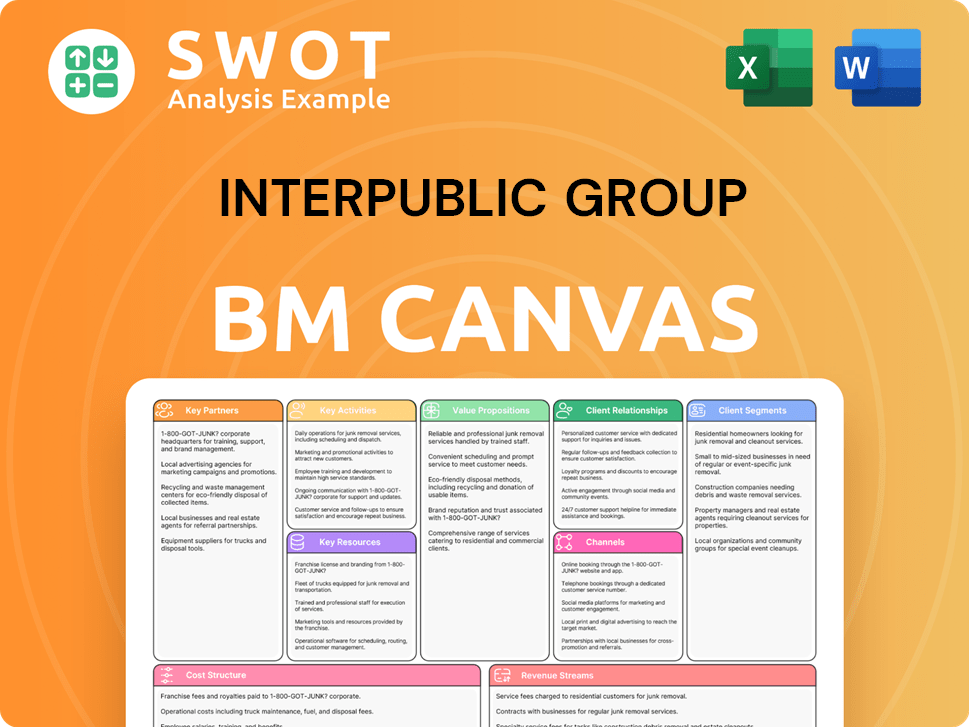
What is the Timeline of Key Events for Interpublic Group?
The IPG history reflects a journey from its formation as a holding company in 1961, succeeding McCann-Erickson, Inc., to its current position as a leading global marketing and advertising agency. Early milestones include rapid global expansion throughout the 1960s and 1970s, followed by significant investments in digital capabilities during the 1990s. Major acquisitions, such as True North Communications in 2001 and Acxiom's Marketing Solutions business in 2018, have shaped the company's evolution. The
IPG company
has consistently adapted to industry changes, including navigating the global pandemic in 2020 and focusing on integrated marketing solutions and data analytics in the 2010s.| Year | Key Event |
|---|---|
| 1961 | Interpublic Group (IPG) is officially formed as a holding company, succeeding McCann-Erickson, Inc. |
| 1960s-1970s | Rapid global expansion through strategic acquisitions of advertising, public relations, and market research agencies. |
| 1990s | Significant investments in digital capabilities as the internet transforms the advertising industry. |
| 2001 | Acquisition of True North Communications, including the Foote, Cone & Belding (FCB) network. |
| 2018 | Acquires Acxiom's Marketing Solutions business for $2.3 billion, enhancing its data and analytics capabilities. |
| 2020 | Navigates the global pandemic, adapting to remote work and shifts in client spending. |
| 2023 | Reports strong revenue growth, with net revenue increasing by 0.5% to $11.64 billion. |
| 2024 | Continues to invest in AI and emerging technologies to enhance its marketing solutions. |
IPG is strategically positioned to capitalize on the increasing importance of data-driven marketing. This involves integrating data and technology platforms across its agencies. This approach allows for more seamless and effective solutions for clients, leveraging advanced analytics.
The company is focused on investing in artificial intelligence and emerging technologies. This will enhance its marketing solutions and maintain a competitive edge. These investments are crucial for adapting to rapid technological advancements.
IPG is focused on expanding its presence in high-growth markets. This includes strategic investments to offer more seamless and effective solutions. The company also aims to continue investing in talent development to stay at the forefront of innovation.
IPG's leadership emphasizes 'intelligent integration', combining creativity with data and technology. This approach is designed to drive measurable results for clients. This forward-looking strategy is key to adapting to evolving client needs.
Interpublic Group Porter's Five Forces Analysis
- Covers All 5 Competitive Forces in Detail
- Structured for Consultants, Students, and Founders
- 100% Editable in Microsoft Word & Excel
- Instant Digital Download – Use Immediately
- Compatible with Mac & PC – Fully Unlocked
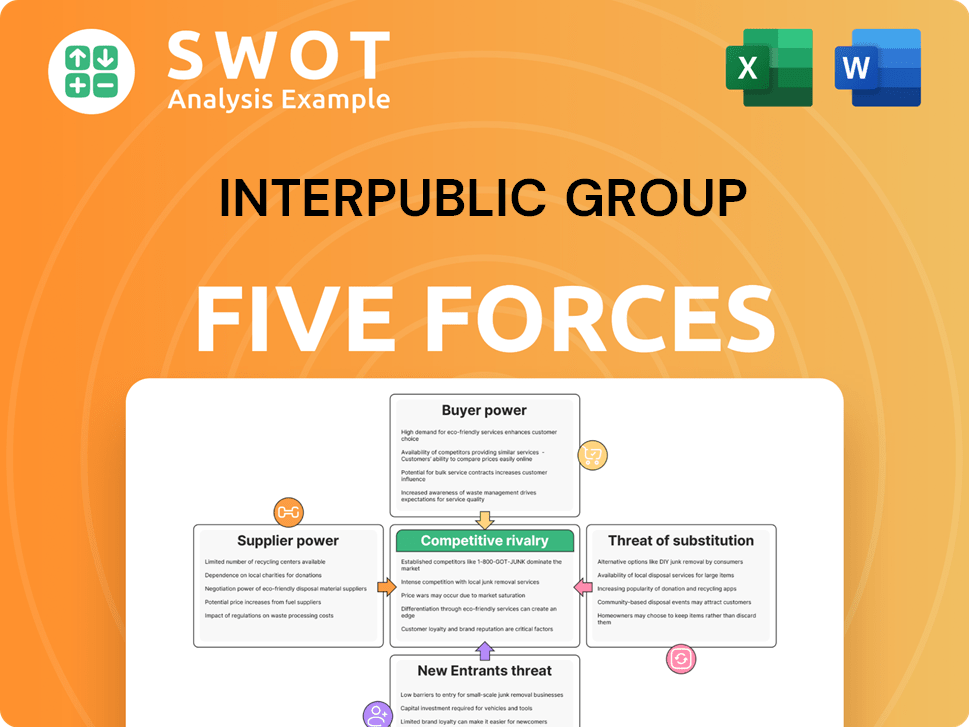
Related Blogs
- What is Competitive Landscape of Interpublic Group Company?
- What is Growth Strategy and Future Prospects of Interpublic Group Company?
- How Does Interpublic Group Company Work?
- What is Sales and Marketing Strategy of Interpublic Group Company?
- What is Brief History of Interpublic Group Company?
- Who Owns Interpublic Group Company?
- What is Customer Demographics and Target Market of Interpublic Group Company?
Disclaimer
All information, articles, and product details provided on this website are for general informational and educational purposes only. We do not claim any ownership over, nor do we intend to infringe upon, any trademarks, copyrights, logos, brand names, or other intellectual property mentioned or depicted on this site. Such intellectual property remains the property of its respective owners, and any references here are made solely for identification or informational purposes, without implying any affiliation, endorsement, or partnership.
We make no representations or warranties, express or implied, regarding the accuracy, completeness, or suitability of any content or products presented. Nothing on this website should be construed as legal, tax, investment, financial, medical, or other professional advice. In addition, no part of this site—including articles or product references—constitutes a solicitation, recommendation, endorsement, advertisement, or offer to buy or sell any securities, franchises, or other financial instruments, particularly in jurisdictions where such activity would be unlawful.
All content is of a general nature and may not address the specific circumstances of any individual or entity. It is not a substitute for professional advice or services. Any actions you take based on the information provided here are strictly at your own risk. You accept full responsibility for any decisions or outcomes arising from your use of this website and agree to release us from any liability in connection with your use of, or reliance upon, the content or products found herein.